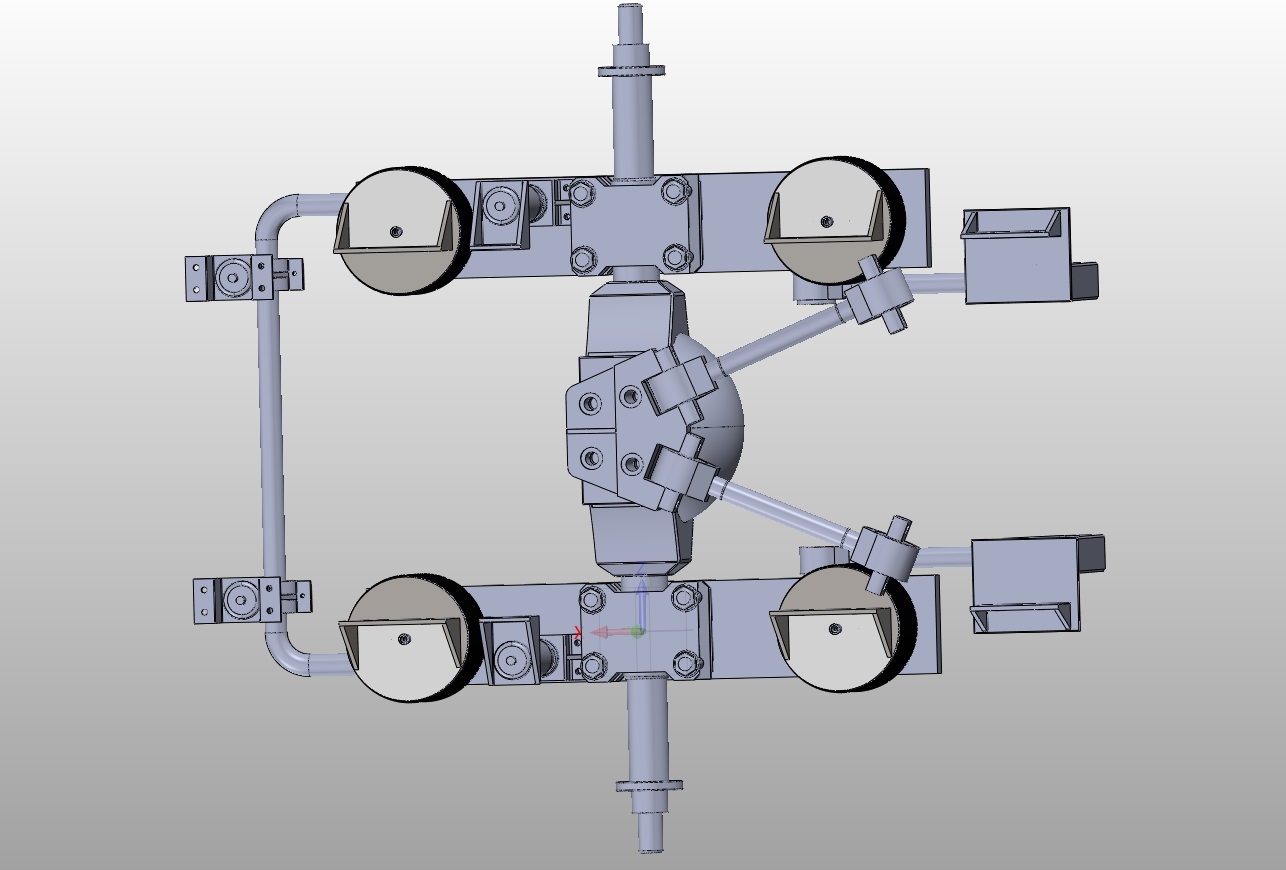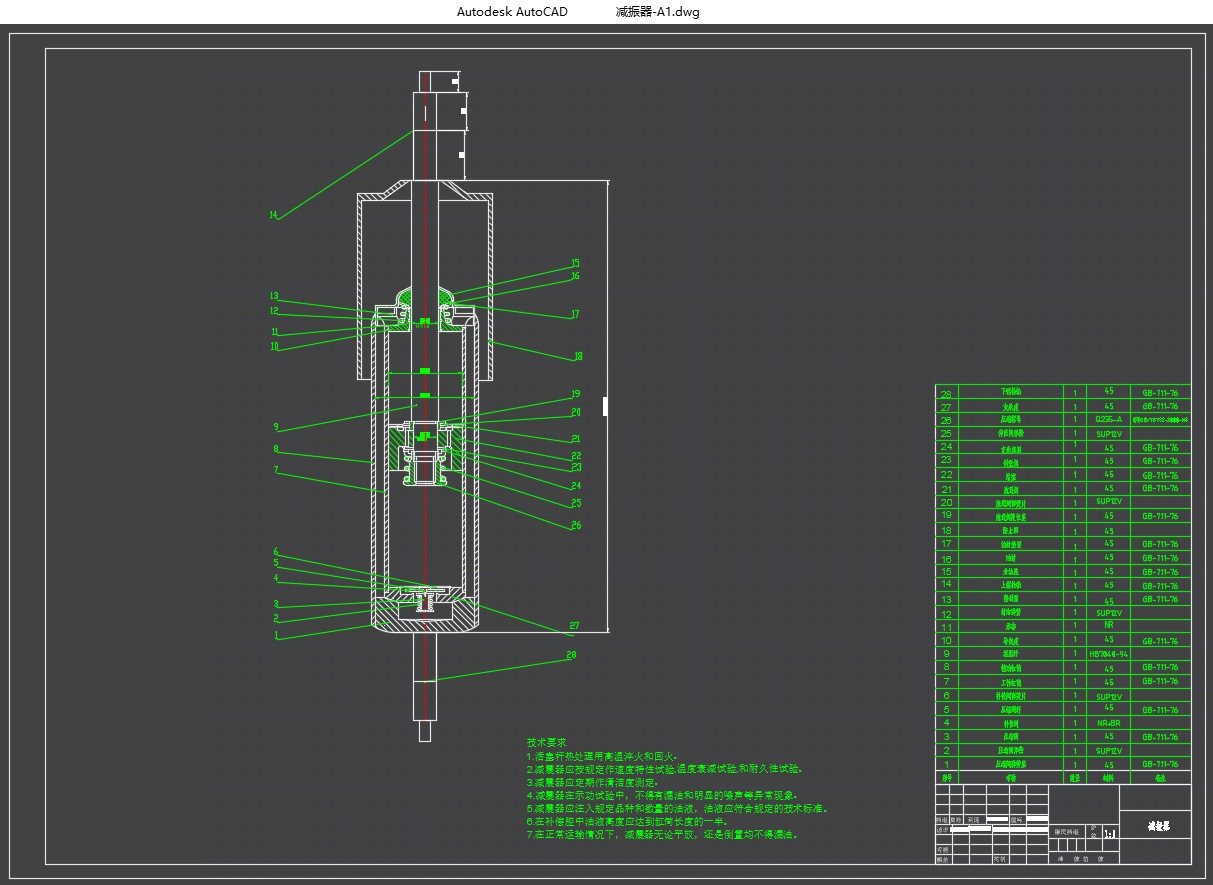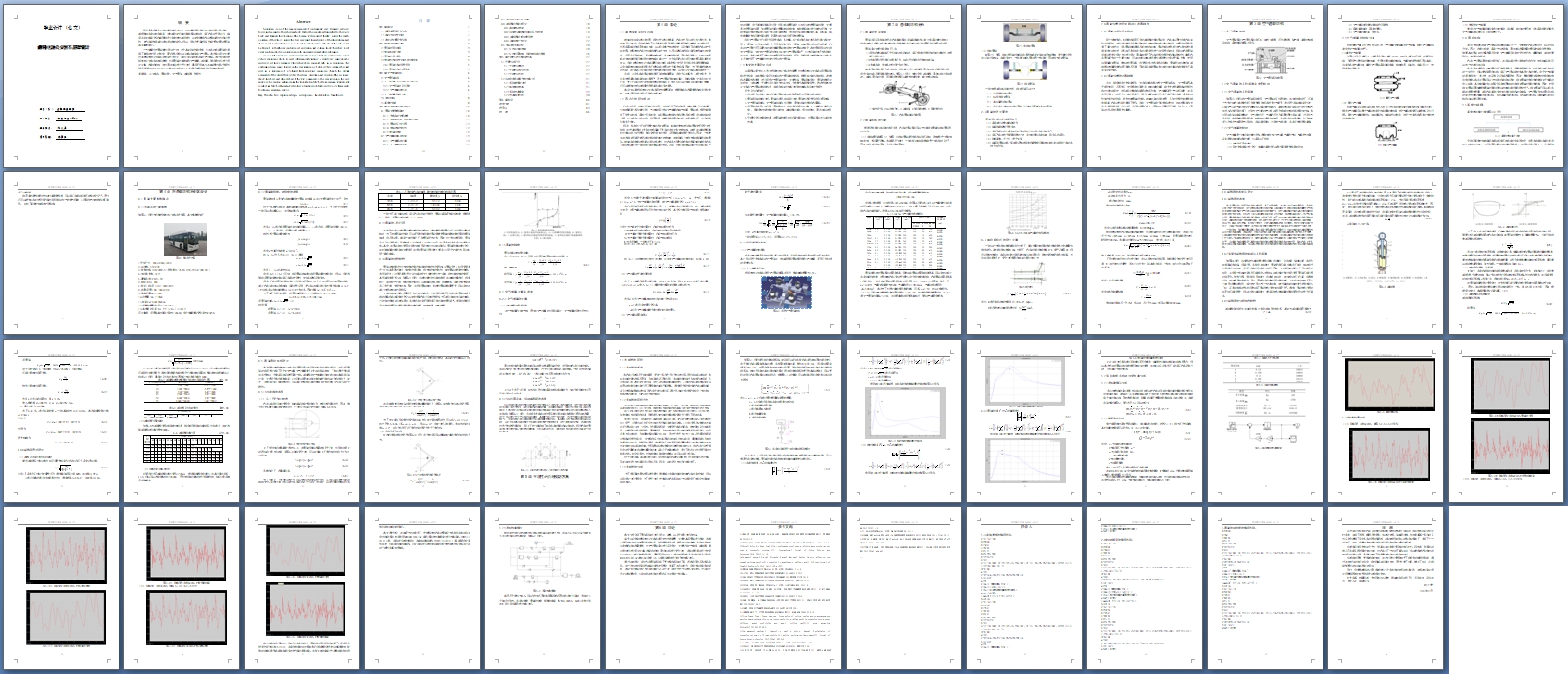燃料电池公交客车悬架设计(含CAD图,SolidWorks三维图)

燃料电池公交客车悬架设计(含CAD图,SolidWorks三维图)(任务书,开题报告,外文翻译,论文说明书15000字,CAD图7张,SolidWorks三维图)
摘 要
悬架是当代汽车上的主要组成部分之一。它主要作用于车轮与车身的所有力和力矩。减缓传给车身的冲击载荷,并衰减由此引起的承载系统的振动,保证汽车的平稳运行;确保车轮在载荷变化和路面起伏时有理想的运动特性,以此来增强汽车的操纵稳定性和轻便性,使汽车能够有良好的加速和爬坡能力。所以,设计出更省材料、性能更加优异的悬架具有重要意义。
空气弹簧作为悬架弹性元件的一种,由于其良好的性能优势,它在各种车辆悬架中得到了普遍的使用,近年来,国内很多中级以上的客车都装有空气悬架。本次毕业设计主要对某燃料电池公交客车后悬架进行设计,选用V型四连杆机构的空气悬架。通过选定的燃料电池公交客车的相关参数,对后悬架的关键部件空气弹簧、减振器、横向稳定杆进行设计计算、选型和校核;并对导向机构进行受力分析,最后采用MATLAB编程对客车平顺性做出评价和MATLAB/Simulink建立双自由度 1/4 车辆车架模型进行动力学仿真分析。
关键词:公交客车;悬架设计;空气悬架;减振器;平顺性
Abstract
Suspension is one of the major components of contemporary cars. It mainly acts on all forces and moments of the wheel and body. Reduce the impact load transmitted to the vehicle body and attenuate the vibration of the bearing system caused thereby, ensure the smooth operation of the vehicle; ensure the ideal movement characteristics of the wheel during load changes and road undulations, so as to enhance the handling stability of the vehicle and Lightweight, so that the car can have good acceleration and climbing ability. Therefore, it is of great significance to design a suspension with more materials and better performance.
As one of the suspension elastic elements, the air spring has been widely used in various vehicle suspensions due to its good performance advantages. In recent years, many domestic mid-level and above passenger vehicles have been equipped with an air suspension. This graduation design mainly focuses on the rear suspension of a fuel cell bus passenger bus, and uses an air suspension of a V-shaped four-bar linkage mechanism. Through the relevant parameters of the selected fuel cell bus, the design, calculation and selection of the air springs, shock absorbers, and stabilizer bars of the key components of the rear suspension; the force analysis of the guiding mechanism and the final adoption MATLAB programming evaluates ride comfort and MATLAB/Simulink establishes a two-degree-of-freedom 1/4 vehicle frame model for dynamic simulation analysis.
[资料来源:http://www.doc163.com]
Key Words:bus;suspension design;air suspension;shock absorber;Smoothness
整车外形图
1外形尺寸: 8540×2450×3280
2.座位数: 56/10-26
3.轮胎规格:255/70R22.5(轮胎直径:255*0.7+22.5*25.4=928.5mm)
4.接近离去角:9/13°
5.最高车速(km/h):69
6.轴距(mm):4600
7.轮距(前/后)(mm):2070/1825
8.前悬/后悬(mm):2000/1940
9.整备质量(kg):8600
10.总质量(kg):12500
11.轴荷(kg):4000/8500kg
12.非簧载质量前/后(kg):440/750
13.单边簧上负荷(N):P=(G- )×9.8/2
可计算得,后悬架单边簧上负荷为17444N,每个弹簧所承受负荷为37975N
[资料来源:www.doc163.com]




 [资料来源:http://doc163.com]
[资料来源:http://doc163.com] 


目 录
第1章 绪论 1
1.1 课题背景及研究内容 1
1.2 国内外的研究现状 1
1.3 本文的主要研究内容 2
第2章 悬架的结构分析 3
2.1悬架功用及组成 3 [来源:http://www.doc163.com]
2.2悬架系统的分类 3
2.3悬架的设计要求 4
2.4悬架技术的研究现状及发展趋势 5
2.4.1悬架技术的研究现状 5
2.4.2悬架技术的发展趋势 5
第3章 空气悬架结构 6
3.1空气悬架组成 6
3.2空气悬架的工作原理及使用特点 6
3.2.1空气悬架的工作原理 6
3.2.2 空气弹簧的特点 6
3.3空气弹簧的结构分类 7
3.4 导向机构 8
3.5高度控制阀 8
第4章 后悬架结构与参数设计 10
4.1 悬架主要参数确定 10
4.1.1 大客车的主要参数 10
4.1.2 悬架静挠度、动挠度的选择 11
4.1.3 悬架的工作行程 12
4.1.4 悬架的弹性特性 12
4.1.5悬架的刚度 13
4.2 空气弹簧计算及选型 13
[版权所有:http://DOC163.com]
4.2.1 空气弹簧的计算 13
4.2.2 空气弹簧的选型 15
4.3 横向稳定杆的设计计算 17
4.4 减振器的选型与设计 18
4.4.1减振器的选型 18
4.4.2双筒式减振器的组成与工作原理 19
4.4.3 减振器的分段线性特性 19
4.4.4 减振器尺寸设计 22
4.5 悬架导向机构设计 24
4.5.1 V形夹角的选择 24
4.5.2 V形杆固定端,活动端跨距的选择 26
第5章 平顺性评价与模型仿真 27
5.1平顺性的评价 27
5.1.1平顺性的概念 27
5.1.2平顺性的评价方法 27
5.1.3平顺性的分析 27
5.2双自由度车辆动力学仿真分析 31
5.2.1系统建模与分析 31
5.2.2路面激励仿真 31
5.2.3系统仿真模型 33
5.2.4仿真结果分析 34 [资料来源:Doc163.com]
第6章 结论 40
参考文献 41
附录A 43
致 谢 46燃料电池公交客车悬架设计(含CAD图,SolidWorks三维图)(任务书,开题报告,外文翻译,论文说明书16200字,CAD图7张,SolidWorks三维图)
摘 要
悬架是当代汽车上的主要组成部分之一。它主要作用于车轮与车身的所有力和力矩。减缓传给车身的冲击载荷,并衰减由此引起的承载系统的振动,保证汽车的平稳运行;确保车轮在载荷变化和路面起伏时有理想的运动特性,以此来增强汽车的操纵稳定性和轻便性,使汽车能够有良好的加速和爬坡能力。所以,设计出更省材料、性能更加优异的悬架具有重要意义。
空气弹簧作为悬架弹性元件的一种,由于其良好的性能优势,它在各种车辆悬架中得到了普遍的使用,近年来,国内很多中级以上的客车都装有空气悬架。本次毕业设计主要对某燃料电池公交客车后悬架进行设计,选用V型四连杆机构的空气悬架。通过选定的燃料电池公交客车的相关参数,对后悬架的关键部件空气弹簧、减振器、横向稳定杆进行设计计算、选型和校核;并对导向机构进行受力分析,最后采用MATLAB编程对客车平顺性做出评价和MATLAB/Simulink建立双自由度 1/4 车辆车架模型进行动力学仿真分析。
[资料来源:http://doc163.com]
关键词:公交客车;悬架设计;空气悬架;减振器;平顺性
Abstract
Suspension is one of the major components of contemporary cars. It mainly acts on all forces and moments of the wheel and body. Reduce the impact load transmitted to the vehicle body and attenuate the vibration of the bearing system caused thereby, ensure the smooth operation of the vehicle; ensure the ideal movement characteristics of the wheel during load changes and road undulations, so as to enhance the handling stability of the vehicle and Lightweight, so that the car can have good acceleration and climbing ability. Therefore, it is of great significance to design a suspension with more materials and better performance.
As one of the suspension elastic elements, the air spring has been widely used in various vehicle suspensions due to its good performance advantages. In recent years, many domestic mid-level and above passenger vehicles have been equipped with an air suspension. This graduation design mainly focuses on the rear suspension of a fuel cell bus passenger bus, and uses an air suspension of a V-shaped four-bar linkage mechanism. Through the relevant parameters of the selected fuel cell bus, the design, calculation and selection of the air springs, shock absorbers, and stabilizer bars of the key components of the rear suspension; the force analysis of the guiding mechanism and the final adoption MATLAB programming evaluates ride comfort and MATLAB/Simulink establishes a two-degree-of-freedom 1/4 vehicle frame model for dynamic simulation analysis. [资料来源:http://doc163.com]
Key Words:bus;suspension design;air suspension;shock absorber;Smoothness
目 录
第1章 绪论 1
1.1 课题背景及研究内容 1
1.2 国内外的研究现状 1
1.3 本文的主要研究内容 2
第2章 悬架的结构分析 3
2.1悬架功用及组成 3
2.2悬架系统的分类 3
2.3悬架的设计要求 4
2.4悬架技术的研究现状及发展趋势 5
2.4.1悬架技术的研究现状 5
2.4.2悬架技术的发展趋势 5
第3章 空气悬架结构 6
3.1空气悬架组成 6
3.2空气悬架的工作原理及使用特点 6
3.2.1空气悬架的工作原理 6
3.2.2 空气弹簧的特点 6
3.3空气弹簧的结构分类 7
3.4 导向机构 8
3.5高度控制阀 8
第4章 后悬架结构与参数设计 10 [资料来源:http://Doc163.com]
4.1 悬架主要参数确定 10
4.1.1 大客车的主要参数 10
4.1.2 悬架静挠度、动挠度的选择 11
4.1.3 悬架的工作行程 12
4.1.4 悬架的弹性特性 12
4.1.5悬架的刚度 13
4.2 空气弹簧计算及选型 13
4.2.1 空气弹簧的计算 13
4.2.2 空气弹簧的选型 15
4.3 横向稳定杆的设计计算 17
4.4 减振器的选型与设计 18
4.4.1减振器的选型 18
4.4.2双筒式减振器的组成与工作原理 19
4.4.3 减振器的分段线性特性 19
4.4.4 减振器尺寸设计 22
4.5 悬架导向机构设计 24
4.5.1 V形夹角的选择 24
4.5.2 V形杆固定端,活动端跨距的选择 26
第5章 平顺性评价与模型仿真 27
5.1平顺性的评价 27 [资料来源:Doc163.com]
5.1.1平顺性的概念 27
5.1.2平顺性的评价方法 27
5.1.3平顺性的分析 27
5.2双自由度车辆动力学仿真分析 31
5.2.1系统建模与分析 31
5.2.2路面激励仿真 31
5.2.3系统仿真模型 33
5.2.4仿真结果分析 34
第6章 结论 40
参考文献 41
附录A 43
致 谢 46
